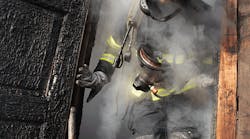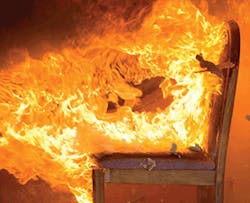Smoked Out: Are Firefighters in More Danger than Ever Before?
At first glance, our towns and neighborhoods may look safer from fire hazards than they were 50 years ago. Today's homes and businesses are equipped with more advanced fire and smoke sensors, and firefighters have more durable safety equipment and a deeper knowledge of fire fighting. American cities also enforce strict fire safety codes and other building regulations to prevent fires and minimize risks when they do occur.
Yet modern buildings are burning and collapsing faster than those that were built 60 or 100 years ago. Published studies indicate residential fires are more difficult to escape and more likely to have quick flashover rates, giving firefighters less time to reach buildings and homes before disaster strikes.
So why are fires actually getting more dangerous and difficult to control? To understand the problem, it's important to know how our modern design, construction, furniture and fuel choices impact the safety of our buildings – and how we can minimize these new fire risks.
How could an element as basic as fire become more dangerous? Shouldn't we have learned from our past mistakes in stopping, harnessing and preventing fires?
It turns out that one key variable has affected our ability to deal with fires: the materials that fuel them. Just as technology has increased our power to detect and fight fires, it also has introduced a variety of modern materials and construction trends that make smoke and fire more difficult to contain.
Some of these more-recent changes include flammable textiles, plastics with high burn rates and less practical building layouts and foundations. It's difficult to pinpoint just one problem; a variety of construction and manufacturing changes have converged to make recent fires hotter and the smoke from those fires more deadly.
Modern Building Materials
One of the biggest changes in city fires is the use of synthetic building materials. While walls once were thicker and lined with heavy-duty construction or insulation materials, today's thinner wall linings are easier for fires to penetrate.
Windows and interior doors also are failing faster, making structures less sustainable when fire happens. According to UL tests, modern windows fail twice as quickly, while doors are failing after only five minutes of fire exposure.
UL calls our synthetic building materials a “perfect storm” of flammability and smoke risks, yet we still favor materials that burn hotter and collapse faster.
Modern homes are, overall, built of lighter materials and more synthetic materials. Thanks to structural components and support systems that trade lumber for engineered joists and other man-made parts, modern homes will likely be more vulnerable for the foreseeable future. But it's not just the construction materials that contribute to this hazard.
Modern Furniture
Plastics have risen in prominence in many industries over the past few decades, and home furnishings are no exception. The modern household is outfitted with a variety of plastics and synthetic textiles. These synthetic fabrics and linings are replacing cotton, wool and other natural materials, which are more expensive and less durable but also are slower to burn.
Plastics have higher heat release rates, which make them more combustible and dangerous than natural materials that have fewer fumes and lower heat release rates. Common synthetic materials include polyurethane foam cushions with hot burn times and deadly fumes, nylon and acrylic upholstery that are full of combustible chemicals and appliances that are full of gases and masses that shouldn't be combined in high-heat situations. Together, all of these modern-day materials join forces to set a deadly trap for unprepared tenants, residents and first responders.
New Smoke, New Dangers
Flames only are part of the problem. Since the advent of synthetic furniture and construction materials, smoke signatures have been identified with 223 percent more frequency. When synthetic materials burn, their smoke often contains dangerous chemicals that kill faster and maim more severely.
When a fire breaks out, synthetic materials such as polyurethane and nylon generate a toxic cyanide gas called hydrogen cyanide that can be deadly in small doses. This toxic gas is found in all kinds of building furnishings, insulation, carpets, appliances, plastics and clothing.
Firefighter Nation estimates that hydrogen cyanide (HCN) is up to 35 percent more dangerous than carbon monoxide (CO), which suffocates the organs. Though CO can kill quickly, HCN attacks the central nervous system, disorienting people who are exposed. HCN exposure can prevent firefighters from effectively managing fires, and everyday citizens from escaping buildings. Both gases are by-products of burning synthetic materials.
What Can We Do?
Building traditions and manufacturing methods always evolve, and it's possible we can reduce our fire and smoke dangers by using less toxic synthetic materials in the future. Until then, we must adapt to the current threats and ensure that building occupants and firefighters develop strategies for controlling risks during fires.
Escape faster – Homeowners and business owners should prioritize faster escape times from buildings. After a fire alarm goes off, don't wait more than 30 seconds to get out, as building materials may emit toxic smoke and deadly heat within minutes.
Fire department training programs – Fire departments increasingly are turning to new training methods and programs to educate fire departments about the new risks. For example, Fire Engineering suggests training programs that help firefighters identify the sources of cyanide, understand the physical and psychological effects of cyanide exposure and learn how to immediately treat it.
Fire safety equipment – There is one piece of fire safety equipment is instrumental in protecting people from these new threats. Though firefighters are exposed to hotter, faster and more toxic fires, they also are armed with a weapon that could save their nervous system and oxygen levels: their self-contained breathing apparatus (SCBA). Every firefighter relies on his or her SCBA to prevent breathing in smoke and toxic fumes. Researchers recommend more in-depth training to make sure firefighters know exactly how to appropriately use their SCBAs.
Fire safety will continue to evolve as we learn more about our risks and develop new strategies for avoiding them. However, if you're like most modern Americans, you're surrounded by synthetic building materials and plastics every day. It's important to rely on fire safety equipment that you know how to use, and make design choices that don't increase your risks.
Carla Williams works in customer and media relations for the Strike First Corp. of America, a leading manufacturer of fire extinguishers and fire extinguisher cabinets.

